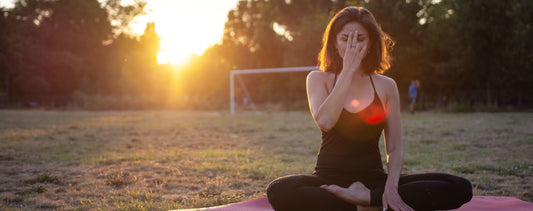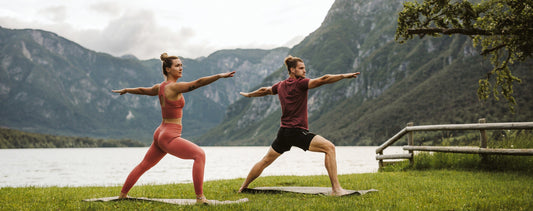More people in the West are practicing yoga than ever before. Doctors are prescribing it, scientists are endorsing it, and some insurance plans are even covering it. Though the physical practice of yoga—the third limb of Patanjali's eight-fold path—has been around thousands of years, asana has recently grown in popularity and the various styles of yoga to choose from.
But where can you start? It seems as though there are as many styles of yoga as there are leaves on a tree. Depending on the city you live in, there may be a yoga studio on every corner. And what about ordering a DVD online? How do you narrow that search down?
While yoga’s popularity is certainly a blessing, it can also feel like a curse—an overwhelming sense of options that can leave you feeling paralyzed instead of empowered. If you’ve ever felt confused about the different styles of yoga, read on to discover the most common styles in America, and discover the one(s) that are best for you.
According to the yogic tradition:
Experience yoga in a new and profound way as Deepak Chopra and Chopra Center master educators guide you through ancient yoga and meditation techniques at our six-day retreat, Seduction of Spirit. Learn More.
But where can you start? It seems as though there are as many styles of yoga as there are leaves on a tree. Depending on the city you live in, there may be a yoga studio on every corner. And what about ordering a DVD online? How do you narrow that search down?
While yoga’s popularity is certainly a blessing, it can also feel like a curse—an overwhelming sense of options that can leave you feeling paralyzed instead of empowered. If you’ve ever felt confused about the different styles of yoga, read on to discover the most common styles in America, and discover the one(s) that are best for you.
The 4 Types of Yoga
It’s important to begin by explaining that the physical practice of yoga (what most people simply call “yoga”) is part of only one of four primary types of yoga that are currently practiced.According to the yogic tradition:
- Karma Yoga is the path of service. Mother Teresa was this type of yoga practitioner. When we serve others without attachment to the results, we are engaging in karma yoga.
- Bhakti Yoga is the yoga of devotion. Regular prayer, chanting, singing, and other expressions of love for the Divine are all forms of bhakti yoga.
- Jnana Yoga is the path of wisdom and intellect. Traditionally, this includes reading sacred texts and engaging in philosophical contemplation.
- Raja Yoga is the “royal path”, and includes Hatha Yoga (or the breath and bodily practices).
Types of Hatha Yoga
-
Hatha: While “Hatha Yoga” distinguishes the path of yoga that involves moving the body with awareness of breath, it also exists as a generic style of yoga that is perhaps the most straightforward. A traditional Hatha Yoga class will most likely include a series of asanas (yoga postures), done one after another, without much attention to the transitions between them. You can expect to hold poses for around five breaths each, making it a fairly accessible practice for most students. Within Hatha Yoga, there can be multiple levels, however, so be sure the class you attend is either labeled “all levels” or something similar.
-
Vinyasa Flow: A very popular style of yoga is Vinyasa, which means “to place in a special way.” More commonly, however, the word is translated as “breath-to-movement,” meaning you are expected to move in and out of the postures with your inhales and exhales. Sun Salutations are practiced in Vinyasa classes, usually followed by variations on similar sequences that emphasize flowing between the poses, rather than starting and stopping as you would in a Hatha class.
-
Ashtanga and Power Yoga: Ashtanga is a dynamic form of hatha yoga that is quite vigorous in how it moves from posture to posture. Vinyasa Flow is actually a modern derivative of Ashtanga yoga, which is a set series of postures that are always repeated. Whereas you can expect different class sequences in each vinyasa class, you will practice the same sequence of poses each time you practice Ashtanga. Because of its physically demanding nature, hybrid classes inspired by Ashtanga are often called Power Yoga classes.
-
Iyengar Yoga: Iyengar yoga is extremely alignment oriented. Named after the world-renowned teacher, BKS Iyengar, this style focuses on precise execution of the yoga postures, and uses props (like blocks, straps, and blankets) to help you find your optimal positioning. Some people find this style intimidating because true Iyengar teachers can often feel like drill-sergeants in the way they demand very specific adherence to the Iyengar guidelines.
-
Anusara® Yoga: A more joyful and inclusive derivative of Iyengar yoga, Anusara Yoga emphasizes alignment and heart-centered movements. Based on Tantric philosophy, this style encourages moving the body as a celebration of our true nature. Anusara is sometimes considered a more “spiritual” style of Hatha yoga than some of the others, and classes usually involve chanting, philosophy, storytelling, and a quality of movement called “flowing with grace.”
-
Bikram Yoga®: Better known as “Hot Yoga,” this style is taught in a room that is kept at approximately 106 degrees Fahrenheit. Bikram yoga (named after its originator, Bikram Choudhury) has only one set series of 26 poses, and is very intense. Plan on sweating profusely, and only even attempt this style if you are free from injuries and physical limitations.
-
Kundalini Yoga: If you have ever seen yogis wearing all white outfits and turbans, they are likely Kundalini practitioners, following the teachings of Yogi Bhajan, who brought his practice to the West in 1968. People practicing Kundalini often chant syllables or mantras, perform specific breathing techniques, and engage in repetitive and invigorating movements (called kriyas) for up to 108 repetitions at a time. Don’t let this intimidate you, however, as Kundalini Yoga is a very welcoming practice and is meant to support its students through transformation.
-
Restorative Yoga: A modern and very relaxing form of yoga is Restorative Yoga, which uses props (like pillows and blankets) to support the body in seated and reclining postures. The purpose here is to relax completely into the props, so you can focus on your breath and relieving your stress. This is a very accessible practice for people with physical limitations and who want to slow down from a fast-paced lifestyle.
-
Yin Yoga: Another style that is increasing in popularity is Yin Yoga—a style that emphasizes longer and more passive holds. What’s different about yin is that it targets the connective tissues rather than the muscles and bones. Many people find this style very relaxing and therapeutic; however, those with a more active mind find the longer periods of quiet to be challenging. You can expect to hold seated, kneeling, and reclining poses for 3-5 minutes at a time.
- AcroYoga: A fun and playful style, Acroyoga is a combination of yoga, acrobatics, and Thai massage that is done with a partner. If you have ever laid on your back with your child up in the air on your feet, then many Acroyoga poses will look familiar. Think of it as a fun way to approach your practice with trust and a playful attitude.
Experience yoga in a new and profound way as Deepak Chopra and Chopra Center master educators guide you through ancient yoga and meditation techniques at our six-day retreat, Seduction of Spirit. Learn More.






















